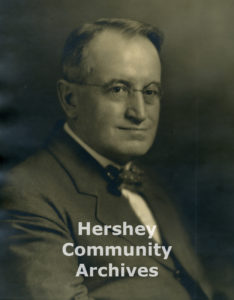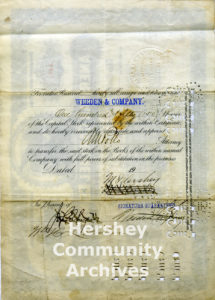HersheyArchives@30, Part 4: Selling the Lancaster Caramel Company

What’s the story behind this American Caramel Company stock certificate? Milton Hershey’s caramel business was called the Lancaster Caramel Company. So why did Milton Hershey own stock in a rival company?
The Lancaster Caramel Company dominated the United States confectionery market. Lancaster Caramel products were distributed nationally and internationally. Even though Lancaster Caramel Company dominated the market, there were competing firms. The American Caramel Company had been organized in 1898 following the merger of three smaller caramel businesses. It had offices in Philadelphia and New York and its managers were very aggressive businessmen.
American Caramel felt that Lancaster Caramel was their only serious rival and the owners tried to persuade Milton Hershey to merge with them. American Caramel Company knew that a merger would allow them to control 95 per cent of the caramel market.
However, Milton Hershey was not interested in the idea of the merger. At first, American Caramel threatened to put Milton Hershey out of business, but Hershey was not intimidated.
Finally, the owners of the American Caramel Company approached Milton Hershey with an offer to buy his business. Milton Hershey responded with interest. Though caramels were a very popular confectionery product, Hershey believed that the caramel market was reaching the end of its popularity. “Caramels are just a fad,” he said.
Negotiations to sell the Lancaster Caramel Company stretched on for months. Finally, in Spring, 1900, the price was finally agreed on: Milton Hershey would sell the company for one million dollars.
Negotiations were not yet concluded. The matter of how the price would be paid needed to be resolved. Milton Hershey’s representative, his lawyer John Snyder, wanted an all cash transaction. Daniel Lafean, the American Caramel Company representative, had other ideas.
Throughout the spring, representatives of the two companies held negotiations.
Our knowledge of the negotiations comes from a 1955 oral history interview with John Myers, who was the stenographer during the talks. John Myers related:
The negotiations took place in Mr. Snyder’s office, 120 East King Street [Lancaster, PA]. There were present Mr. Hershey, and John Snyder; representing the other people was Congressman Lafean of York [PA] and a representative of the Providence Trust Company of Providence, Rhode Island.
The first offer of the [American Caramel Company] people was $500,000 in cash and an equal amount in stock. The agreed on price was a million dollars. The price was understood. I know. I was there. I was the stenographer.
The second offer was $750,000 in cash and $250,000 in stock.
The third offer was $900,000 in cash and $100,000 in stock.
Hershey had left it to Mr. Snyder because he trusted him with anything at all. But when Snyder refused that last offer, Mr. Hershey became quite angry.
Milton Hershey wanted to sell and he felt that $900,000 cash and $100,000 in stock was a good offer. He didn’t want the American Caramel Company to pull out at this point. And he also wanted to keep the good will of Lafean whose company might very well be customers in buying Hershey Chocolate coatings for their caramels. However, he knew that Snyder had set his heart on receiving one million dollars in cash and he wanted somehow to save Snyder’s pride.
So the discussion between Milton Hershey and his lawyer lasted a long time and when it was over Snyder had his way. Lafean’s third offer was refused, and the American Caramel Company agreed to pay cash for the full amount.
But although it appeared that Hershey and John Snyder had driven a hard bargain, it was not Hershey’s way to let his opponents feel that they had been taken advantage of. Quietly, he agreed that after the one million dollar check had been handed him, he would spend a large part of it to purchase American Caramel Company stocks and bonds.
The sale of the Lancaster Caramel Company was finally completed on August 10, 1900. Milton Hershey surrendered the factory, the machinery, the stock in hand, his formulas, and the “Crystal A” trademark. He also agreed not to make caramels in Lancaster. But he retained the ownership of the Hershey Chocolate Company and he kept all his chocolate-making machinery. He also rented a wing of the caramel factory from the new owners in which he continued to make chocolate.
While Milton Hershey agreed to purchase American Caramel Company stock with sale monies, he had no intention of keeping the stock as a long term investment. He directed John Snyder to sell the American Caramel stock as soon as was prudent. Just a few months later, the first of Milton Hershey’s American Caramel Company stock was sold.*
*It turned out Milton Hershey was right in his assessment of the future of caramels in the confectionery market. By the 1920s, the American Caramel Company was faltering and a few years later collapsed in bankruptcy.

